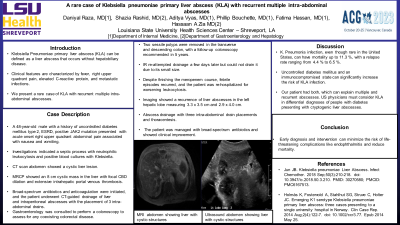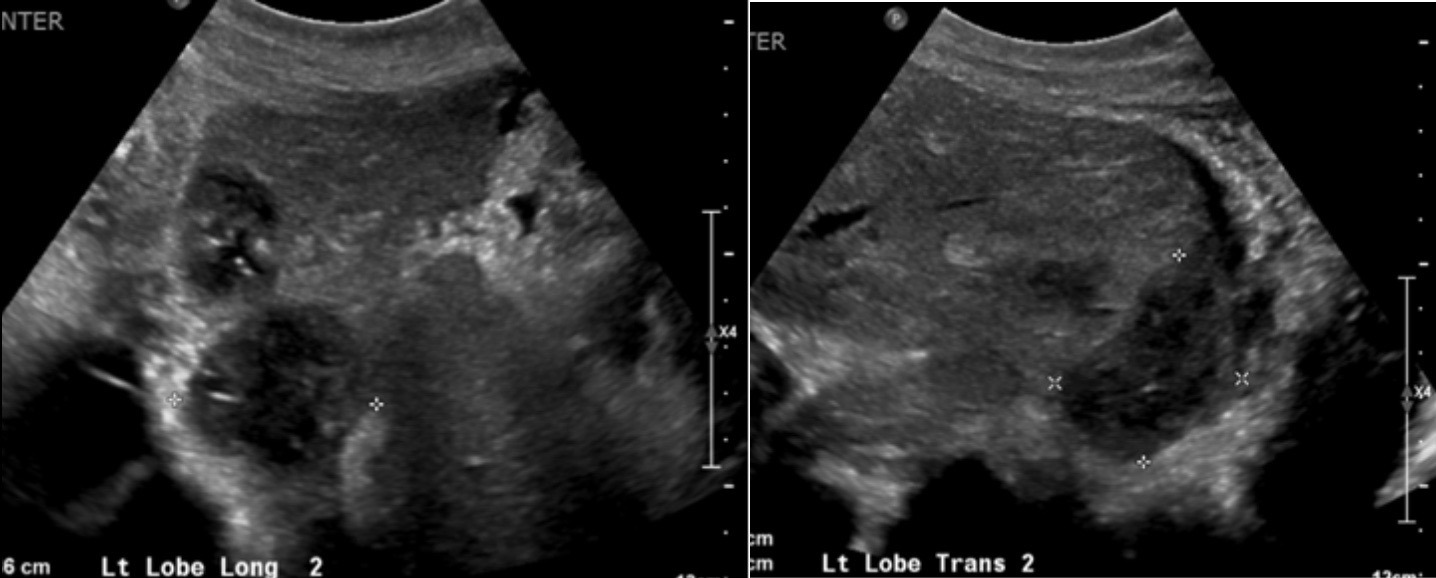Tuesday Poster Session
Category: Biliary/Pancreas
P2919 - A Rare Presentation of Recurrent Klebsiella pneumoniae Liver Abscess
Tuesday, October 24, 2023
10:30 AM - 4:00 PM PT
Location: Exhibit Hall

Has Audio
.jpeg.jpg)
Daniyal Raza, MD
LSU Health Sciences Center
Shreveport, LA
Presenting Author(s)
Daniyal Raza, MD, Shazia Rashid, MD, Aditya Vyas, MD, Philip Bouchette, MD, Fatima Hassan, MD, Hassaan A. Zia, MD
LSU Health Sciences Center, Shreveport, LA
Introduction:
Klebsiella pneumoniae primary liver abscess (KLA) refers to the occurrence of a liver abscess without underlying hepatobiliary disease. This condition has seen a rise in reported cases, particularly in Southeast Asia, over the past 20 years. Typical clinical features of KLA include fever, right upper quadrant pain, elevated C-reactive protein levels, and the possibility of metastatic infections. K. Pneumoniae infection can lead to the development of multiple abscesses, which can be life-threatening if left untreated. We present a rare case of KLA with recurrent intra-abdominal abscesses.
Case Description/Methods: A 48-year-old male with type 2 diabetes, end-stage renal disease due to diabetic nephropathy, JAK 2 mutation, pancreatic transplant on tacrolimus and a failed renal transplant presented with abdominal pain, nausea and vomiting. Diagnostic investigations revealed signs of a septic process, including neutrophilic leukocytosis and positive blood cultures for Klebsiella. US and CT scan of the abdomen detected a cystic lesion in the liver, prompting further evaluation with an MRCP which showed an 8 cm cystic mass in the liver, focal dilation of the common bile duct, and extensive intrahepatic portal venous thrombosis. Treatment involved initiating broad-spectrum antibiotics, anticoagulation therapy, and CT-guided drainage of liver and intraperitoneal abscesses. Gastroenterology performed a colonoscopy, which identified and removed 2 sessile polyps in the colon. The patient completed the antibiotic course and was discharged but later readmitted due to recurrent febrile episodes and worsening leukocytosis. Repeat imaging revealed recurrent liver abscesses, which were drained again. The patient showed improvement with antibiotics and had the drains removed before being discharged. Follow-up appointments with transplant medicine, hepatology, and infectious disease were scheduled.
Discussion: Although uncommon in the United States, (K. pneumoniae) infection can be associated with a mortality rate of up to 11.3% and a relapse rate ranging from 4.4% to 6.5%. The presence of uncontrolled DM and an immunocompromised state significantly increases the risk of KLA and the development of multiple and recurrent abscesses, as seen in our patient's case. It is crucial for physicians consider KLA in the differential diagnosis of individuals with diabetes who present with cryptogenic liver abscesses. Early diagnosis and intervention are essential to minimize the risk of life-threatening complications.

Disclosures:
Daniyal Raza, MD, Shazia Rashid, MD, Aditya Vyas, MD, Philip Bouchette, MD, Fatima Hassan, MD, Hassaan A. Zia, MD. P2919 - A Rare Presentation of Recurrent Klebsiella pneumoniae Liver Abscess, ACG 2023 Annual Scientific Meeting Abstracts. Vancouver, BC, Canada: American College of Gastroenterology.
LSU Health Sciences Center, Shreveport, LA
Introduction:
Klebsiella pneumoniae primary liver abscess (KLA) refers to the occurrence of a liver abscess without underlying hepatobiliary disease. This condition has seen a rise in reported cases, particularly in Southeast Asia, over the past 20 years. Typical clinical features of KLA include fever, right upper quadrant pain, elevated C-reactive protein levels, and the possibility of metastatic infections. K. Pneumoniae infection can lead to the development of multiple abscesses, which can be life-threatening if left untreated. We present a rare case of KLA with recurrent intra-abdominal abscesses.
Case Description/Methods: A 48-year-old male with type 2 diabetes, end-stage renal disease due to diabetic nephropathy, JAK 2 mutation, pancreatic transplant on tacrolimus and a failed renal transplant presented with abdominal pain, nausea and vomiting. Diagnostic investigations revealed signs of a septic process, including neutrophilic leukocytosis and positive blood cultures for Klebsiella. US and CT scan of the abdomen detected a cystic lesion in the liver, prompting further evaluation with an MRCP which showed an 8 cm cystic mass in the liver, focal dilation of the common bile duct, and extensive intrahepatic portal venous thrombosis. Treatment involved initiating broad-spectrum antibiotics, anticoagulation therapy, and CT-guided drainage of liver and intraperitoneal abscesses. Gastroenterology performed a colonoscopy, which identified and removed 2 sessile polyps in the colon. The patient completed the antibiotic course and was discharged but later readmitted due to recurrent febrile episodes and worsening leukocytosis. Repeat imaging revealed recurrent liver abscesses, which were drained again. The patient showed improvement with antibiotics and had the drains removed before being discharged. Follow-up appointments with transplant medicine, hepatology, and infectious disease were scheduled.
Discussion: Although uncommon in the United States, (K. pneumoniae) infection can be associated with a mortality rate of up to 11.3% and a relapse rate ranging from 4.4% to 6.5%. The presence of uncontrolled DM and an immunocompromised state significantly increases the risk of KLA and the development of multiple and recurrent abscesses, as seen in our patient's case. It is crucial for physicians consider KLA in the differential diagnosis of individuals with diabetes who present with cryptogenic liver abscesses. Early diagnosis and intervention are essential to minimize the risk of life-threatening complications.

Figure: Ultrasound of the abdomen showing liver with cystic structures
Disclosures:
Daniyal Raza indicated no relevant financial relationships.
Shazia Rashid indicated no relevant financial relationships.
Aditya Vyas indicated no relevant financial relationships.
Philip Bouchette indicated no relevant financial relationships.
Fatima Hassan indicated no relevant financial relationships.
Hassaan A. Zia indicated no relevant financial relationships.
Daniyal Raza, MD, Shazia Rashid, MD, Aditya Vyas, MD, Philip Bouchette, MD, Fatima Hassan, MD, Hassaan A. Zia, MD. P2919 - A Rare Presentation of Recurrent Klebsiella pneumoniae Liver Abscess, ACG 2023 Annual Scientific Meeting Abstracts. Vancouver, BC, Canada: American College of Gastroenterology.
